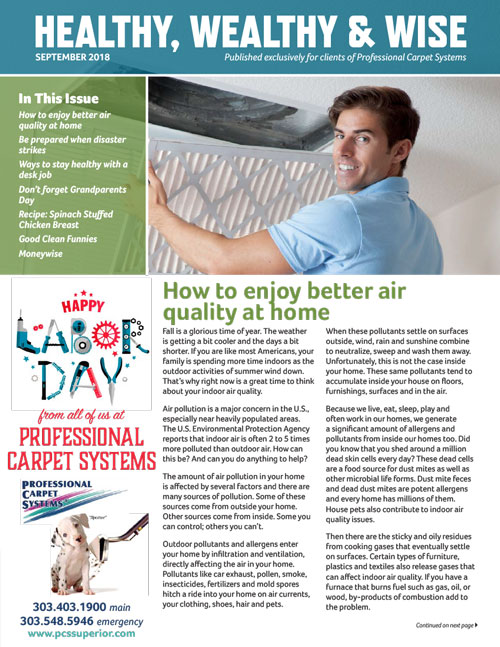Here’s our September 2018 Client Newsletter.
Click Here to see the full newsletter
How to enjoy better air quality at home
Fall is a glorious time of year. The weather is getting a bit cooler and the days a bit shorter. If you are like most Americans, your family is spending more time indoors as the outdoor activities of summer wind down. That’s why right now is a great time to think about your indoor air quality.
Air pollution is a major concern in the U.S., especially near heavily populated areas. The U.S. Environmental Protection Agency reports that indoor air is often 2 to 5 times more polluted than outdoor air. How can this be? And can you do anything to help?
The amount of air pollution in your home is affected by several factors and there are many sources of pollution. Some of these sources come from outside your home. Other sources come from inside. Some you can control; others you can’t.
Outdoor pollutants and allergens enter your home by infiltration and ventilation, directly affecting the air in your home. Pollutants like car exhaust, pollen, smoke, insecticides, fertilizers and mold spores hitch a ride into your home on air currents, your clothing, shoes, hair, and pets.
When these pollutants settle on surfaces outside, wind, rain, and sunshine combine to neutralize, sweep and wash them away. Unfortunately, this is not the case inside your home. These same pollutants tend to accumulate inside your house on doors, furnishings, surfaces and in the air.
Because we live, eat, sleep, play and often work in our homes, we generate a significant amount of allergens and pollutants from inside our homes too. Did you know that you shed around a million dead skin cells every day? These dead cells are a food source for dust mites as well as other microbial life forms. Dust mite feces and dead dust mites are potent allergens and every home has millions of them. Housepets also contribute to indoor air quality issues.
Then there are the sticky and oily residues from cooking gases that eventually settle on surfaces. Certain types of furniture, plastics, and textiles also release gases that can affect indoor air quality. If you have a furnace that burns fuel such as gas, oil, or wood, by-products of combustion add to the problem.
After all of this, you may wonder if it is safe to stay in your home. Don’t be alarmed. There is a lot you can do to improve indoor air quality. Invest high-quality air filters for your HVAC (heat, ventilation, air-conditioning) system. These lters are rated based on their e ciency at trapping tiny particles. The rating is called MERV. The higher the MERV rating, the more e ective the lter.
Professional duct cleaning helps to remove contaminants that accumulate on the inner surfaces of your HVAC system.
Use a vacuum cleaner equipped with HEPA ltration. HEPA lters trap the smallest particles including dust mite feces, dead skin, pollen and mold spores. Other vacuum cleaners simply spew these tiny particles back into the air, making matters worse.
Use bathroom exhaust fans and range hoods to remove excessive humidity and cooking gases that can contribute to indoor air pollution. High humidity encourages bacteria and mold growth.
Cleaning carpets, upholstery, and area rugs returns them to a healthful condition and improves indoor air quality by removing pollutants and allergens that bond to these surfaces.
Cleaning your carpets, rugs and upholstery right now makes perfect sense. You are going to be spending more time indoors. You and your family deserve a clean, healthy home. If you have guests visiting for the holidays, your home will look, smell and feel fresh and clean.
Call Professional Carpet Systems today to schedule your fall cleaning. You and your family will breathe easier.

